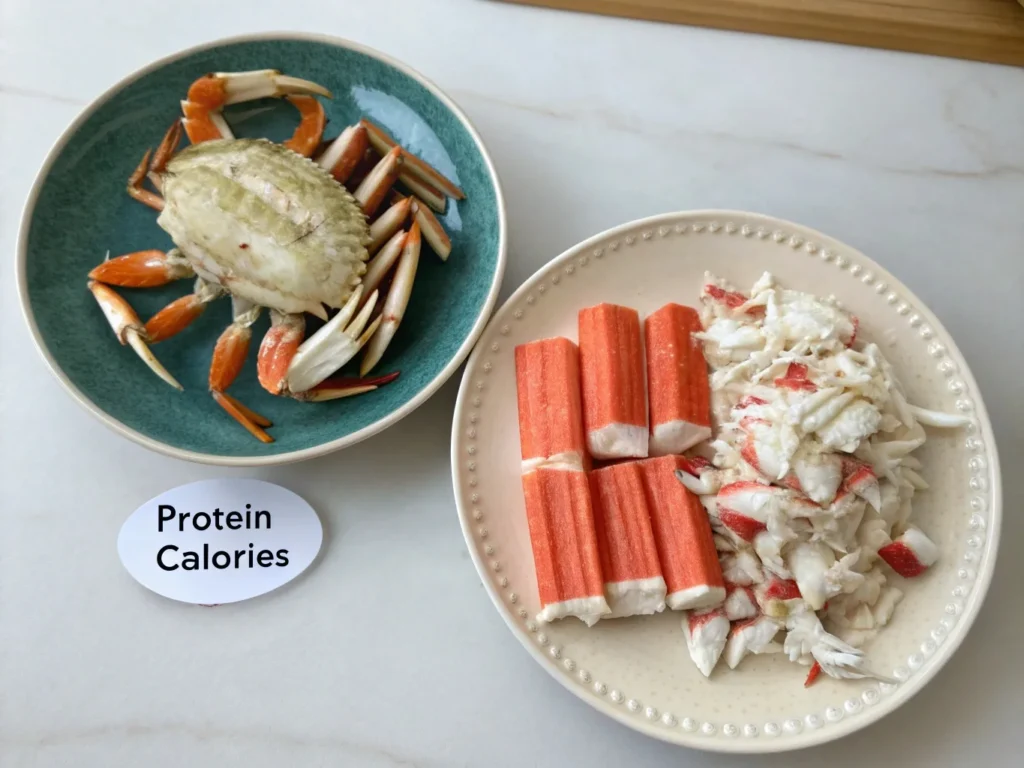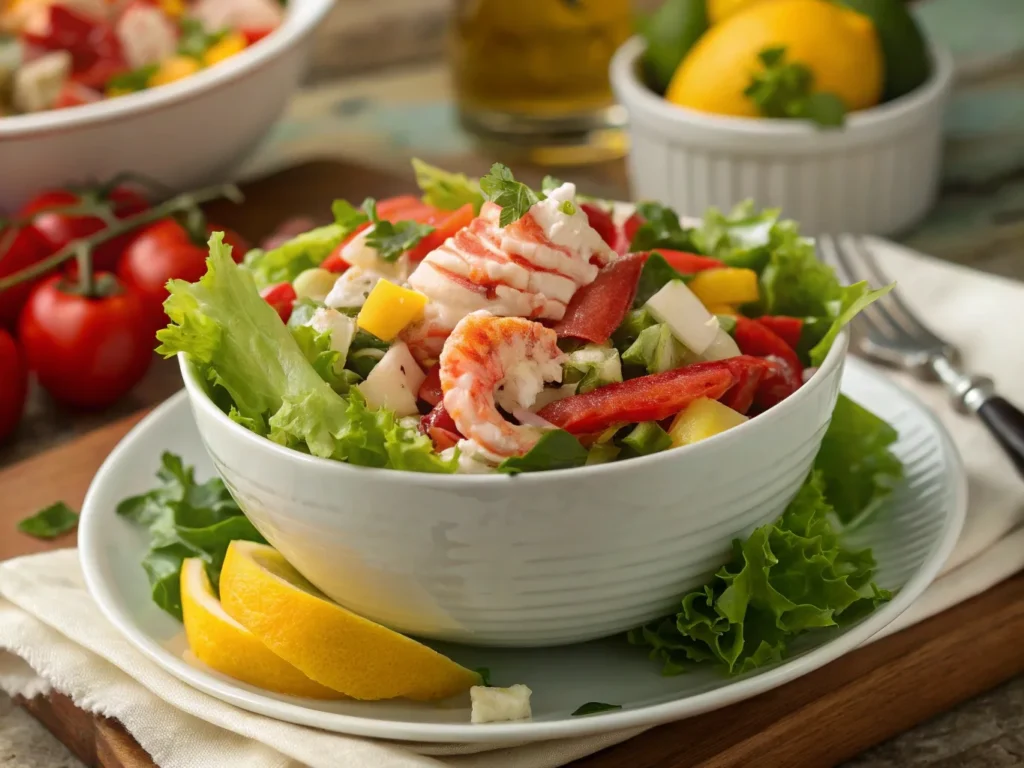Is imitation crab meat healthy? This budget-friendly seafood alternative is widely used in sushi, salads, and quick meals in the U.S. But is it a good choice for your diet? Understanding its nutrition and ingredients is essential for making informed food decisions.
It’s mainly made from surimi, which is 35%–50% fish paste. This processed seafood is designed to look and taste like real crab. Knowing its nutrition facts is key for healthy eating.
Unlike real seafood, imitation crab has fish, starches, salt, and oils. Its bright color might attract you. But, the processing questions its nutritional value.

Key Takeaways
- Imitation crab is a processed seafood product with limited nutritional benefits
- Contains approximately 81 calories per 3-ounce serving
- Made mainly from surimi and various additives
- Lower in protein than real crab meat
- Offers an affordable alternative to traditional seafood
What Is Imitation Crab Meat Made Of?
Imitation crab meat, also known as mock crab, is a seafood alternative. It’s made from a mix of ingredients that might surprise you.
Primary Ingredients of Surimi
Surimi is the base of imitation crab meat. It mainly uses Alaska pollock, which is 50% to 75% of global surimi. Surimi makes up 35% to 50% of the product. The main ingredients are:
- Alaska pollock
- Water
- Egg whites
- Cornstarch
- Sugar
Nutritional Additives
Mock crab gets extra ingredients to taste and feel better. Some common additives include vegetable oil, salt, and stabilizers. But, these can also have health risks like phosphates and carrageenan.
Comparison to Real Crab Meat
| Nutritional Aspect | Imitation Crab | Real Crab |
|---|---|---|
| Calories (per 100g) | 94 | 87 |
| Protein | 7g | 18g |
| Sodium | 529mg | 293mg |
Imitation crab is cheaper than real crab, costing about one-third as much. It’s a good choice for those watching their budget.
The Nutritional Profile of Imitation Crab Meat
Knowing the nutrition facts of imitation crab meat helps you make better food choices. It might seem like a healthy option, but its nutritional profile is different from real crab meat.
Caloric Content
A single 85-gram serving of imitation crab has about 81 calories. This is a bit lower than real crab meat, making it a good choice for those watching their calories.
Protein Levels
Imitation crab has about 6.5 grams of protein per serving. This is less than real crab meat but can help meet your daily protein needs. Remember, the protein comes from processed fish, not whole seafood.
| Nutrient | Imitation Crab (85g) | Real Crab (85g) |
|---|---|---|
| Calories | 81 | 71 |
| Protein | 6.5g | 15.6g |
| Fat | 0.4g | 0.5g |
| Carbohydrates | 12.8g | 0g |

Vitamins and Minerals
Imitation crab is a good source of some important nutrients. It has 21% of the Daily Value for vitamin B12, 35% for selenium, and 19% for phosphorus. These minerals are key for keeping your body healthy and working well.
Even though imitation crab can be part of a healthy diet, it’s not a perfect substitute for real seafood. Its processed nature is a key difference.
Can Imitation Crab Meat Be Part of a Healthy Diet?
Imitation crab meat has some health benefits worth noting. Is it healthy to eat imitation crab meat? It depends on its nutritional value and specific benefits.
Imitation crab meat is a good mix of nutrients for a balanced diet. It has about 100 calories in a 3-ounce serving. This makes it a low-calorie protein source that can help with weight management.

Calorie-Conscious Choice
For those watching their calories, imitation crab meat is a great choice. It has fewer calories than many other protein sources. A typical serving has around 100 calories, helping you stay on track with your diet without losing flavor.
Omega-3 Fatty Acid Content
Imitation crab meat doesn’t have as much omega-3 fatty acids as real crab. But, it does offer some heart-healthy nutrients. These nutrients add to your overall diet.
| Nutritional Aspect | Imitation Crab Meat Value |
|---|---|
| Calories per 3-oz serving | 100 |
| Protein content | 10-15 grams |
| Fat content | 1 gram |
| Vitamin B12 | 5-10% Daily Value |
Your diet choices are important. Adding imitation crab meat to meals in moderation can be beneficial. It offers low-calorie nutrition and a mild seafood taste.
Potential Drawbacks of Imitation Crab Meat
Imitation crab meat is easy to use but has some downsides. It’s important to think about these before you start eating it.
High Sodium Content Concerns
Imitation crab meat has a lot of sodium. A 3-ounce serving has 300 to 500 milligrams. That’s about 30% of what the American Heart Association says you should have in a day. If you’re watching your blood pressure or heart health, this might not be good for you.
| Sodium Comparison | Amount per 3-oz Serving | Percentage of Daily Limit |
|---|---|---|
| Imitation Crab Meat | 300-500 mg | 30% |
| Recommended Daily Limit | 1,500-2,300 mg | 100% |
Potential Allergens and Sensitivities
Imitation crab meat also has allergens and additives. Ingredients like egg whites, wheat, and monosodium glutamate (MSG) can cause problems. MSG might even give headaches to up to 20% of people.
Additional Health Considerations
Imitation crab meat isn’t as nutritious as real crab. It has less vitamins and more carbs. If you have special dietary needs, talk to your doctor before eating it often.
How Often Can You Eat Imitation Crab Meat?
It’s important to know how imitation crab meat fits into a balanced diet. Is it healthy to eat it? It depends on your nutritional needs and health goals.
Recommended Serving Sizes
Nutritionists say to eat imitation crab meat in moderation. Aim for 2-3 servings a week. Each serving is about 3 to 4 ounces, which is a good mix of nutrients without too much sodium.
| Serving Size | Nutritional Impact |
|---|---|
| 3 ounces | 95 calories, 7.62g protein |
| 4 ounces | 127 calories, 10.16g protein |
Frequency of Consumption
Your health affects how often you can eat imitation crab meat. If you’re sensitive to sodium or have dietary limits, be careful.
Consider your diet, protein needs, and any allergies. If you’re allergic to shellfish, stay away from imitation crab meat. It might have small amounts of shellfish proteins.
Eating imitation crab meat in moderation is best. It’s a convenient protein source, but don’t forget to include whole, nutrient-rich seafood in your meals.
Alternatives to Imitation Crab Meat
Looking for crab meat substitutes? You have many tasty seafood options to try. Knowing the nutritional differences helps you choose better.
Real Crab Meat: A Superior Option
Real crab meat is the best seafood choice. It beats imitation crab in nutrition. Alaskan king crab, for example, has 16.5 grams of protein per serving. That’s more than imitation crab’s 6.5 grams.
| Nutritional Comparison | Imitation Crab | Alaskan King Crab |
|---|---|---|
| Calories | 81 | 82 |
| Protein (g) | 6.5 | 16.5 |
| Carbohydrates (g) | 12.8 | 0 |
| Fat (g) | 0.4 | 1.3 |
If you’re interested in learning more about why king crab is so expensive and whether it’s worth the price, check out this detailed guide: Why is King Crab So Expensive?
Other Seafood Alternatives
Check out other seafood options to replace imitation crab. Shrimp, pollock, and white fish are great choices. They offer different tastes and keep your diet balanced.
When picking seafood, think about protein, how it’s prepared, and your diet needs. Fresh seafood is usually healthier than processed.
Cooking with Imitation Crab Meat
Imitation crab meat is a great choice for those looking for seafood alternatives. It’s easy to use in many recipes because it’s already cooked. This makes it simple to add to various dishes.

Popular Recipe Ideas
Imitation crab can be turned into tasty meals with little effort. It’s perfect for making California rolls. It’s also great in cold seafood salads, pasta dishes, wraps, and appetizers.
Preparation Tips
Remember, imitation crab is already cooked. Handle it gently to avoid breaking it. You can serve it cold or warm it a bit for hot dishes. Cutting it into small pieces helps spread the flavor.
| Dish Type | Preparation Method | Serving Suggestion |
|---|---|---|
| Salads | Chop finely | Mix with mayo, herbs |
| Sushi | Slice lengthwise | Roll with rice, nori |
| Hot Dishes | Lightly heated | Add to pasta, stir-fries |
Get creative with imitation crab to make tasty meals. Try different seasonings to bring out its mild taste.
Is Imitation Crab Meat Safe for Everyone?
Imitation crab meat has unique safety challenges for certain groups. Knowing the risks helps you make better choices about this seafood product.
Pregnancy and Dietary Precautions
Pregnant women should be careful with imitation crab meat. It has low mercury levels, but its processed nature is a concern. The ingredients might include additives that need careful review during pregnancy.
Seafood Allergy Considerations
People with seafood allergies need to be very cautious with imitation crab meat. Even though it’s made from fish, it may have other allergens like egg whites and preservatives. These can cause severe reactions.
| Dietary Group | Safety Considerations | Recommended Approach |
|---|---|---|
| Pregnant Women | Potential additive risks | Consult healthcare provider |
| Seafood Allergy Sufferers | Multiple possible allergens | Strict avoidance recommended |
| Individuals with MSG Sensitivity | Possible hidden MSG | Check ingredient labels carefully |
Is it healthy to eat imitation crab meat? It depends on your health. Always read labels, know your dietary limits, and ask nutrition experts if unsure about food choices.
FAQ
Is eating imitation crab good for you?
Imitation crab can be a convenient and affordable seafood option, but it has some drawbacks. While it is low in calories and contains some protein, it is highly processed and often contains additives, artificial flavorings, and a high amount of sodium. If consumed in moderation as part of a balanced diet, it can be a reasonable choice, but it lacks the nutritional benefits of real crab meat.
What is imitation crab meat actually made of?
Imitation crab meat is made primarily from surimi, which is a paste created from white fish, usually Alaska pollock. Other ingredients include starches, egg whites, sugar, salt, and various additives to enhance texture and flavor. It is colored and shaped to resemble real crab meat, but its composition is very different from fresh seafood.
What are the disadvantages of crab meat?
Real crab meat is highly nutritious, but it does have some drawbacks. It can be expensive and may contain higher levels of cholesterol. Some species of crab may also carry environmental contaminants like mercury, though generally, crabs have lower mercury levels than some other seafood. Additionally, those with shellfish allergies should avoid crab meat altogether.
Can you eat imitation crab as is?
Yes, imitation crab meat is pre-cooked during processing, so it is safe to eat straight from the package. It can be enjoyed cold in salads, sushi rolls, or sandwiches, or it can be lightly heated in cooked dishes like pasta, soups, and stir-fries. However, avoid overcooking it, as this can affect its texture.
How often can you eat imitation crab meat?
For most people, eating imitation crab meat 2-3 times a week in moderation is considered safe. However, because it is processed and often high in sodium and additives, it should not be a staple in your diet. Instead, balance it with whole, nutrient-rich seafood like real crab, shrimp, or salmon to get better overall nutrition.
Conclusion
Deciding if imitation crab meat is healthy depends on your diet and health goals. It has 63% of its calories from carbs, making it less suitable for low-carb diets.
It’s important to eat it in moderation and know your nutritional needs. Imitation crab has some protein but lacks the nutrients of real crab. FDA rules help us know what’s in processed foods like surimi, but they often have added sugars and fillers.
If you eat imitation crab, watch your portion sizes and eat more whole foods. Those on keto or low-carb diets might want to skip it. Your health goals and dietary needs should decide if you include it in your diet.
Balancing It With Other Foods
Use imitation crab as an occasional ingredient, not a mainstay. Mix it with veggies, lean proteins, and whole grains for a balanced meal. Try different proteins like real crab, shrimp, or salmon for a varied diet.
Making Informed Choices
Read labels and understand what’s in processed foods. Talk to a nutritionist for advice. While imitation crab is convenient, it shouldn’t replace whole foods in your diet.
For more delicious seafood-inspired dishes, be sure to check out our Crab Brulee Recipe, a creative and indulgent take on traditional seafood flavors.
